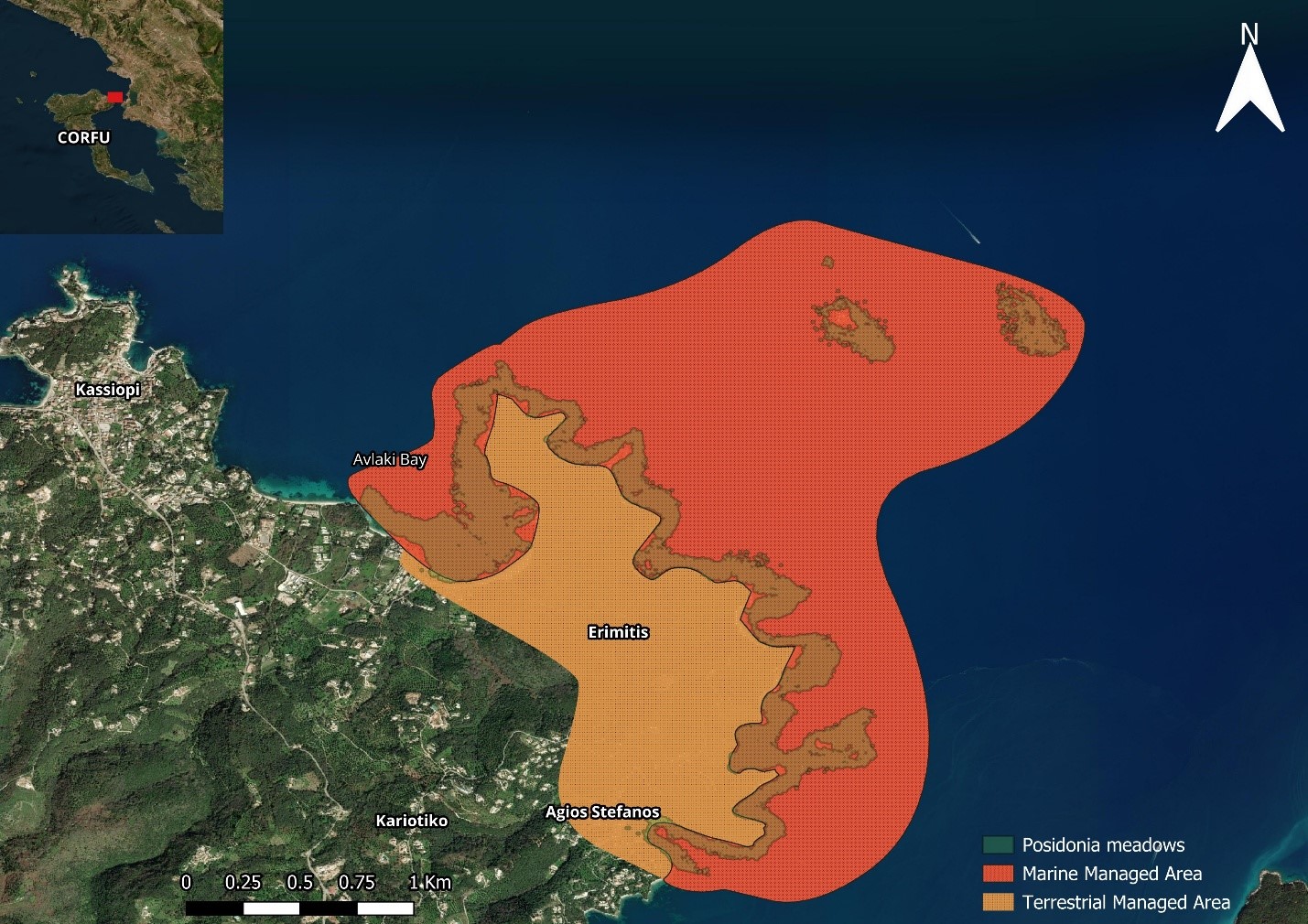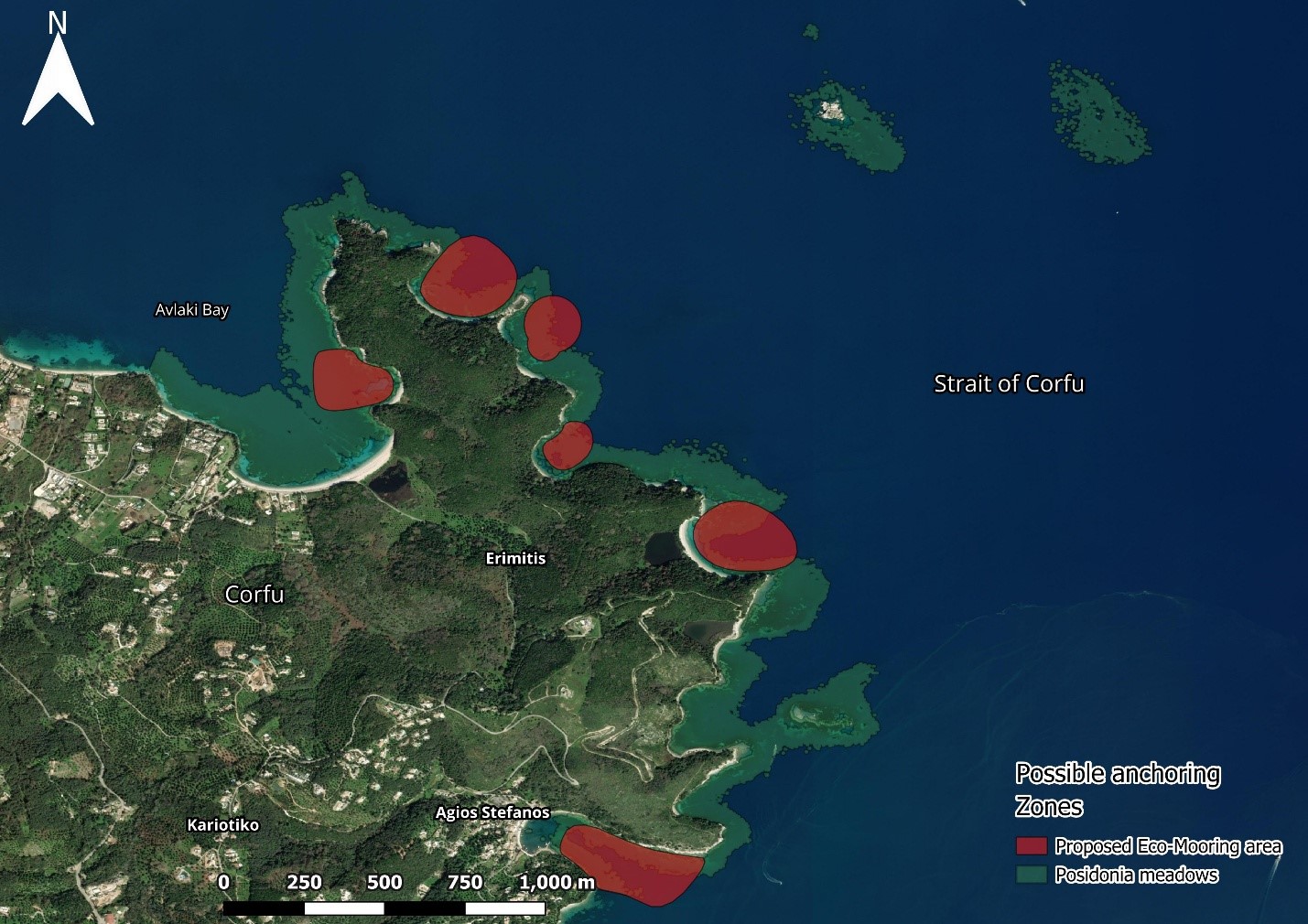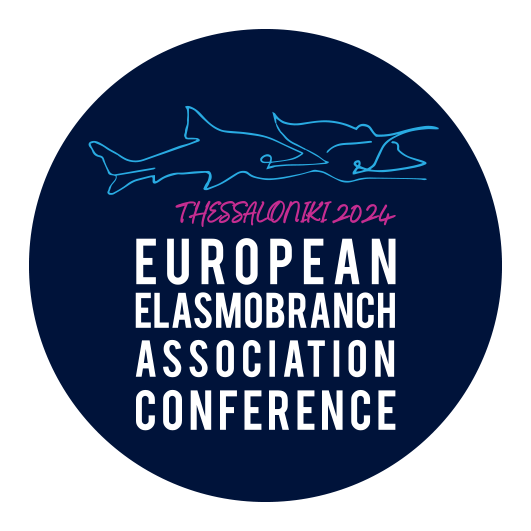The present document has been developed by the environmental organisation iSea ha has been working in the area of Erimitis since 2021 in collaboration with the local community association Erimitis Plous and the support of Blue Marine Foundation and Ionian Environment Foundation. The management Plan reflect the proposals of the local community association and takes into account the results and insights derived from scientific research on land and sea habitats over the years. More about the project can be found here.
Declaration of conflict of interest:
The authors declare that they have no known competing financial interest of personal relationship that could have appeared to influence the work reported in this report.
1. Introduction
1.1. Social-Ecological context of Erimitis
The Eastern Ionian Sea is the area with the most extended meadows(~440 km2) of Posidonia oceanica in Greece, after the North South Aegean Sea. The Peninsula of Erimitis possess one of the richest and diverse habitats in the Ionian Sea, including large shallow inlets and bays, extensive Posidonia meadows, rocky reefs, sandbanks, submerged or partially submerged sea caves. The terrestrial part also consists of a largely virgin dense forest, scrubland with maquis vegetation, coastal lagoons and salt marshes. Three of these habitats are considered EU priority habitats.
Nevertheless, anthropogenic activities including uncontrolled anchoring, proposed large-scale coastal development (such as holiday homes and hotel units), marine traffic, pollution, invasive species and aquacultures are threatening Erimitis peninsula.
But not everything is lost, for more than 12 years, different legal, scientific, social and communicational campaigns like the campaign “Save Erimitis” lead by the environmental association “Erimitis Plous Environmental Protection of the Northern Straight of Corfu” advocating the protection of the peninsula, had thwarted the plans of the destruction of the ecosystem which include the construction of various tourist facilities such as a hotel unit, luxury residences, restaurants, bars, small shops, parking lots, a desalination plant, a wastewater treatment plant and a port facility in the bay of Vromolimni, and several bungalows on the hill of Erimitis with other supporting infrastructure. Alongside this effort preliminary research has been done both on the terrestrial and marine habitats to showcase the ecological importance of the site by identifying priority species and habitats with the goal to ultimately protect the area against development (Athinaiou et al., 2023, 2024, 2025; Giovos et al., 2022; Naasan Aga Spyridopoulou et al., 2021; Papadopolou, 2020)
Since Greece as already achieve his EU commitment of protect 30% of its land and sea by 2030 the possibility of transform this peninsula in a Marine Protect Area is more challenging. However, the eagerness of the people to protect this pristine area had arisen a new type of approach in the Mediterranean, which is to convert this peninsula in a Locally Managed Marine Area (LMMA).
1.2. LMMA approach
A Locally Managed Marine Area (LMMA) is a marine area (including the coast and surroundings) where a significant portion of the management plan is developed and implemented by the local community with the help and support of the local and/or regional government and NGOs. After 4 years of data collection and working alongside the association of Erimitis Plous we decided that this approach is the best fit to the objectives of protecting the area. The reasons why this was chosen are as follows:
-
- Empowers Local communities: it recognizes small-scale fishers and other local users as rights-holders and primary stewards.
- Integrates Knowledge: it blends modern scientific data with the knowledge held by local fisheries, boat owners, boat operators, and the local community.
- Increases compliance: Rules co-designed by the community are more likely to be respected and self-enforced.
- Promotes adaptability: it allows for flexible, rapid adjustments to management as environmental and social conditions change.
- People support: The community of Erimitis is willing and eager to protect this area as pristine as possible.
- Economical opportunities: The creation of new economical incomes for the local community will make large scale development investments irrelevant to the community.
Based in scientific data, and local knowledge the Erimitis LMMA could be cover the coastal waters and the terrestrial area surrounding the peninsula with a total of 711 hectares (186 hectares for the terrestrial part and 525 hectares for the marine area) (See Map. 1). However, Based on the data collected by a Non-Government Organization (iSea) in the past 3 years and the local community, no zonation will be implemented. But, depending on the results, effectiveness and response of the local community a zonation linking the islets with the mainland can be applied in the future. At this stage of the management plan the area will be treated as one zone with general rules to follow.

Map. 1: Map of the potential Marine and Terrestrial protected areas and the location of the Posidonia meadows
3.1. Vision Statement
A thriving and protected natural environment in Erimitis where marine and terrestrial biodiversity flourishes, the unique landscape is preserved, local communities are empowered as stewards of their natural home, and sustainable livelihoods based on low-impact activities are secured for current and future generations.
3.2. Guiding principles
All management decisions will be guided by the following principles:
-
- Ecosystem-based management: Decisions will consider the entire ecosystem, humans and single species alike.
- Precautionary principles: Where there is a threat of serious or irreversible damage, a lack of full scientific certainty will not be used as a reason for postponing cost-effective measures to prevent environmental degradation.
- Community Co-Management: Management authority and responsibility are shared between local government bodies and local communities.
- Adaptive Management: the plan is a cycle of doing, monitoring, and adapting. Management actions will be regularly reviewed and modified based on the results of the monitoring program.
- Transparency and Equity: All decisions and their justifications will be made openly. The benefits and cost of management will be distributed equitably among stakeholders.
4.1. Erimitis Marine Co-management Committee (EMCC)
The primary governing body for the LMMA is the Erimitis Marine Co-management Committee (EMCC).
4.2. Composition of the EMCC
The committee shall be composed of 13 Voting members and 2 non-voting advisors, representing the key stakeholder groups.
-
- Small-Scale Fishers Association (1 representatives)
- Recreational Fishers (1 representatives)
- Tourism sector ( 5 representatives: 1 from dive centre, 1 from boat rental, 1 from boat cruises, 1 for restaurants, 1 for accommodation)
- Local NGOs, (1 representative)
- Municipality of North Corfu (1 representative)
- Hellenic Coast Guard (Port authority) (1 representative, non-voting advisory role).
- Regional Authority of Erimitis Area (1 representative)
- Land-owners (1 representative)
- Scientific committee (1 representative, non-voting advisory role)(Detail information about the committee in point section 4.4).
4.3. Roles and Responsibilities of the EMCC
-
- Review of annual monitoring reports
- Propose and approve amendments to management rules and zoning characterisation.
- Resolve conflicts of interest between user’s groups
- Act as the primary link between the community and the government authorities
- Oversee the financial management of the LMMA
- Lead public awareness and initiatives
4.4 Scientific committee
The committee would be composed by 1 or more environmental organizations or science experts working in the area recollecting scientific valid data. Only one representative of this committee will be in the EMCC as a non-voting member.
4.4.1. Roles of Scientific Committee
-
-
- Collect scientific valid data of Erimitis peninsula.
- Write final report about the ecological status of Erimitis.
- Monitoring of the protection measures adopted in the LMMA to determine their effectiveness.
- Share the final results of the monitoring status with the EMCC and general public.
- Advise the EMCC about possible improvements or changes in the protection measurements adopted in the LMMA.
-
- Anchoring in Posidonia meadows should be avoid it. Instead anchoring should happen in sandy patches or the designated proposal areas (Appendix 1).
- Vessel transit speed is encouraged to 5 knots to reduce noise pollution and vessel collision with wildlife.
- Sustainable recreational and professional fishing techniques are encouraged find more in section 5.1.
- Beaches are to remain free form permanent tourist furniture (sunbeds, umbrellas) to preserve their natural beauty.
5.1. Sustainable fisheries management
5.1.1. Minimum Landing Sizes: Minimum landing sizes for key commercial species are encouraged to allow for greater spawning potential (see Appendix 3: List of Minimum landing sizes)
5.1.2. Seasonal closures: A seasonal closure for Dusky grouper (Ephinephelus marginatus) and other species during their spawning season will be encourage across the entire area (see Appendix 3 for the season for reproduction).
5.1.3. Presence of eggs: If a species is caught presenting eggs and is still alive it will be encouraged to be released.
5.1.4. “Erimitis Sustainable catch” label: A voluntary certification scheme will be developed for fishers adhering to the LMMA rules, allowing them to market their catch at a premium to restaurants and consumers, creating a direct economic incentive for conservation.
5.2. Habitat and biodiversity protection
5.2.1. Anchoring regulations: A public awareness campaign on the impacts of anchoring will be launched.
5.2.2. A program to install ecofriendly moorings buoys (Specially in areas like Aylaki and Akoli).
5.2.3. Species protection: All visitors should respect the code of conduct. It is strictly forbidden to harass, approach, or feed protected species such as mediterranean monk seals (Monachus monachus), sea turtles, and cetaceans. A code of conduct for wildlife watching will be mandatory for all tour operators. You can find the code of conduct here.
5.2.4. Wetland protection: Hunting would be limited and progressively phased out in and around the wetlands to protect their unique flora and fauna.
5.2.5. Forest and grassland Management: Fire protection measures will be developed. Sustainable, traditional activities like beekeeping would be permitted and encourage in grassland areas.
5.3. Sustainable Tourism Management
5.3.1. Code of conduct and sustainable practices: All marine and terrestrial tours operators, boats business, and sailing business would have to adhere to a code of conduct and sustainable practices which includes covering waste disposal, wildlife interactions, and anchoring practices.
5.3.2. Capacity management: The number of occupants (divers/snorkellers/boats cruises, boat rentals and boat sailings) permitted per day will be capped and managed in a booking system. The number of occupants will be decided after a capacity study is developed.
5.3.3. Visitors’ contribution scheme : A voluntary “ Conservation donation” (The amount would be decided later on) per person will be encourage for all marine-based tours, with funds directed to the LMMA management funds.
5.3.4. Sustainable Trails: In collaboration with an environmental association, the existing walking trails will be enhanced and promoted as “Paths of Culture”, linking natural heritage with the area’s rich history and providing opportunities for high-quality ecotourism.
5.3.5. Increase accessibility at specific beaches.
Monitoring plan is essential for adaptive management
6.1. Ecological monitoring
6.1.1. Fish populations: Annual Underwater Visual Census (UVC) in the month of September at fixed sites inside and outside the LMMA
6.1.2. Habitat health: Bi-annual (every two years) monitoring of Posidonia meadows density and health at fixed sites inside and outside the LMMA.
6.1.3. Citizen science: The use of the platform iNature will be promoted for divers, fishers, hikers and general public to log sightings of keys species.
6.2. Socio-Economic Monitoring:
6.2.1. Fisheries: Monthly collecting of Catch Per Unit Effort (CPUE) data from volunteer fishers.
6.2.2. Community: annual survey of stakeholder perceptions, income levels, and conflict incidents.
6.3. Evaluations and Reporting: A report will be produced annually by the scientific advisor and presented to the EMCC and the public. Based on this report, the EMCC will formally review the effectiveness of the plan and propose amendments as needed every two years.
A stratified approach to enforcement will be used:
Appendix 4. Community stewardship: Empowering community members to educate peers and report infractions via a dedicated line (online form). The use of an application called novoville to report infractions would be proposed.
Appendix 5. Sanctions: Infractions will be prosecuted under existing national law. The EMCC will advocate for a legal mechanism to channel a portion of fines back into the LMMA management fund.
Long-term operations of the LMMA will be funded throw a diversified portfolio:
8.1. Public funds: Annual budget allocation from the Municipality of Corfu
8.2. User-Generated revenue: Income from the Visitor contribution scheme and mooring buoys usage fees.
8.3. Private sector partnership: “supporter of Erimitis LMMA” program for hotels, restaurants, and business to contribute in exchange for public recognition.
8.4. External grants: proactive and continuous applications for national and EU funding.
If you would like to know more about, past, current and future projects, developed in the peninsula as well as useful information about LMMA you can read the next resources.
Further resources
Γαστεράτος, Ι. 2022. ΕΡΗΜΙΤΗΣ: Ορνιθοπανίδα, θηλαστικά, συνδεσιμότητα, Παρουσίαση, Ο Ερημίτης Μετά, Κέρκυρα, 4 Ιουλίου.
Καλούδης, Κ. 2022. ΠΡΟΤΑΣΗ ΓΙΑ ΕΝΑ ΒΙΩΣΙΜΟ ΜΕΛΛΟΝ ΓΙΑ ΤΗ ΧΕΡΣΟΝΗΣΟ ΤΟΥ ΕΡΗΜΙΤΗ, Παρουσίαση, Ο Ερημίτης Μετά, Κέρκυρα, 4 Ιουλίου.
Λατινόπουλος, Δ. 2022. Οι οικοσυστημικές υπηρεσίες του Ερημίτη, Παρουσίαση, Ο Ερημίτης Μετά, Κέρκυρα, 4 Ιουλίου.
Παπαδοπούλου, Ε. 2020. Το θαλασσιο περιβαλλον του Ερημιτη και μια καταστροφικη λιμενικη εγκατασταση.
Παπαδοπούλου, Ε. 2022. ΕΡΗΜΙΤΗΣ: Υγρότοποι, Παρουσίαση, Ο Ερημίτης Μετά, Κέρκυρα, 4 Ιουλίου.
Athinaiou, I., Pyloridou, K., Giatroudaki, I., Cecconi, F., & Naasan Aga Spyridopoulou, R. 2025. Exploring the ecological importance of Erimitis Peninsula: Final Progress Report. iSea, Thessaloniki, Greece, 33pp.
Athinaiou, I., Pyloridou, K., Giatroudaki, I., Cecconi, F., Naasan Aga Spyridopoulou, R. 2025. The Ecological Importance of Erimitis Marine Area. An Inventory of Knowledge. Update 2024. iSea, Greece, 16pp.
Athinaiou, I., Pyloridou, K., Poursanidis, D., Naasan Aga Spyridopoulou, R. 2023. Exploring the ecological importance of Erimitis, NE Corfu, Final Project Report. iSea, Greece, 21pp.
Giovos, I., Gkikas, R., Poursanidis, D., Papathanasiou, V., Naasan Aga Spyridopoulou, R. 2022. Estimating the ecological status and blue carbon stock of the Posidonia oceanica (Linnaeus) Delile, 1813 meadows of northeast Corfu Island. iSea, Greece, 14pp.
LMMA Network. (n.d.). About the LMMA Network. Retrieved October 26, 2023, from https://lmmanetwork.org
Naasan Aga Spyridopoulou, R., Gkikas, R., Giovos, I. 2021. Posidonia oceanica (Linnaeus) Delile, 1813 meadows of northeast Corfu. iSea, Greece, 14pp.
Zotaj, A. 2010. Butrint National Park Management Plan. The Albanian Society for the Protection of Birds and Mammals.
Appendix 1: Map of the potential anchoring zones for boat cruises and sailing boats.

Appendix 2. List of the Minimum and Maximum Landing size, and the spawning season proposed for the commercial species caught in Erimitis peninsula. A full guide list can be found here.
Access the rest of the appendices here.
